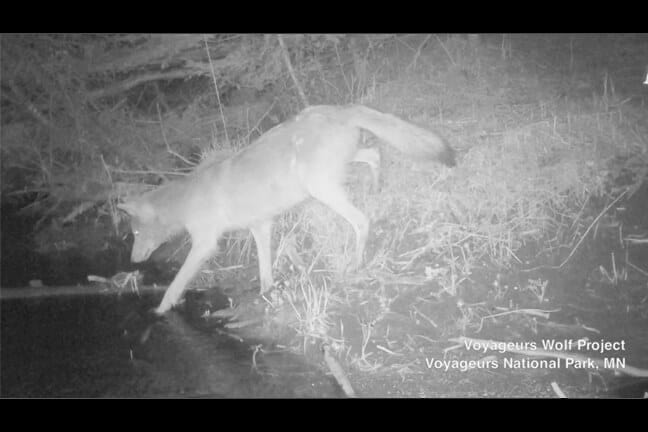The Voyageurs Wolf Project, a collaboration between the University of Minnesota and Voyageurs National Park, has followed GPS-collared wolves from over seven different packs since 2015, but the “Bowman Bay” pack was recently caught displaying a unique behavior: hunting freshwater fish.
Most people think of wolves as predators that only kill large mammals like moose and deer, but this new UMN research published in Mammalian Biology shows that wolves are highly adaptable predators capable of finding unique food sources.
Using GPS collars, the team collects location data from wolves in over seven packs every 20 minutes. This enables them to determine pack territory and predation behaviors in and just to the south of the park.
In April 2017, UMN Ph.D. candidate Tom Gable hiked to a creek where one of the collared wolves had spent a lot of time. “As I approached the area, I briefly saw a wolf trying to catch a fish before it ran into the woods,” said Gable. Afterward, he found fish remains and wolf tracks scattered along the creek. In the following month the team found the two GPS-collared wolves in the “Bowman Bay” pack spent 43-63% of their time hunting fish around this creek.
While fish were not the primary prey over the course of the summer, they were clearly an important food source. Short-term responses to secondary foods, such as freshwater fish, can be uncommon and difficult to document, but they demonstrate how adaptable wolves are when hunting and foraging. This adaptability has allowed wolves to occupy a variety of different habitats in North America, Europe, and Asia.
The same behavior was noticed in early spring 2018 as well, and the team quickly put out camera traps to gather evidence. By the end of the season, they recovered the footage of this rare behavior. Rarer still, the video shows the wolves fishing at night.
“The wolves are standing next to the creek in the dark, just listening or looking,” recounts Gable. “You can see the wolves abruptly head to the water several times after hearing a splash—they learned what a fish splashing in the creek sounds like and they know that it means food. Incredible.”
The Voyageurs Wolf Project has followed wolves from over seven different packs since 2015, the “Bowman Bay” pack is the only one that has hunted fish (primarily spawning suckers).

The GPS collars allow the team to uncover many aspects of the secret lives of wolves from the variety in their summer diets (fish, berries, bear bait, and gut piles left by hunters) to the distinct boundaries held by each pack. The team mapped the result of 68,000 GPS locations visited by the different packs this past summer, a map which recently caught the eye of nearly 50,000 Reddit users.
Wolves are known to feast on spawning salmon in coastal environments in British Columbia and Alaska, but wolves hunting freshwater fish has not been described in detail before. “Given the impressive adaptability of wolves to find food, it is not entirely surprising,” said project advisor Joseph Bump, UMN associate professor and Gordon W. Gullion Endowed Chair in Forest Wildlife Research & Education. “Since wolves are a difficult species to document—especially in the densely forested areas of northern Minnesota—you have to either be in the right spot at the right time or have access to GPS-collar data.”
Funding for this study was provided by the University of Minnesota’s Department of Fisheries, Wildlife and Conservation Biology; Bell Museum; Minnesota Environment and Natural Resources Trust Fund; Van Sloun Foundation; Rainy Lake Conservancy; Northern Michigan University; and Voyageurs National Park.



